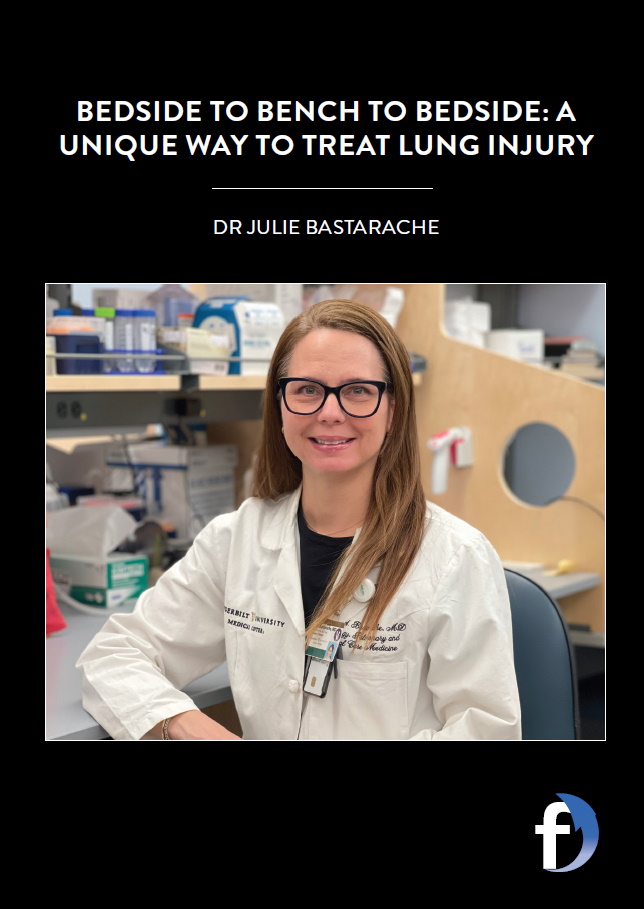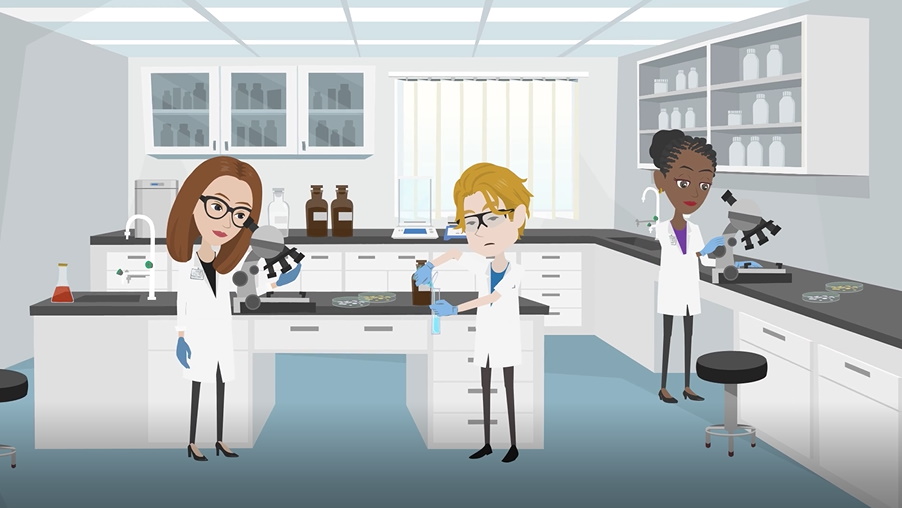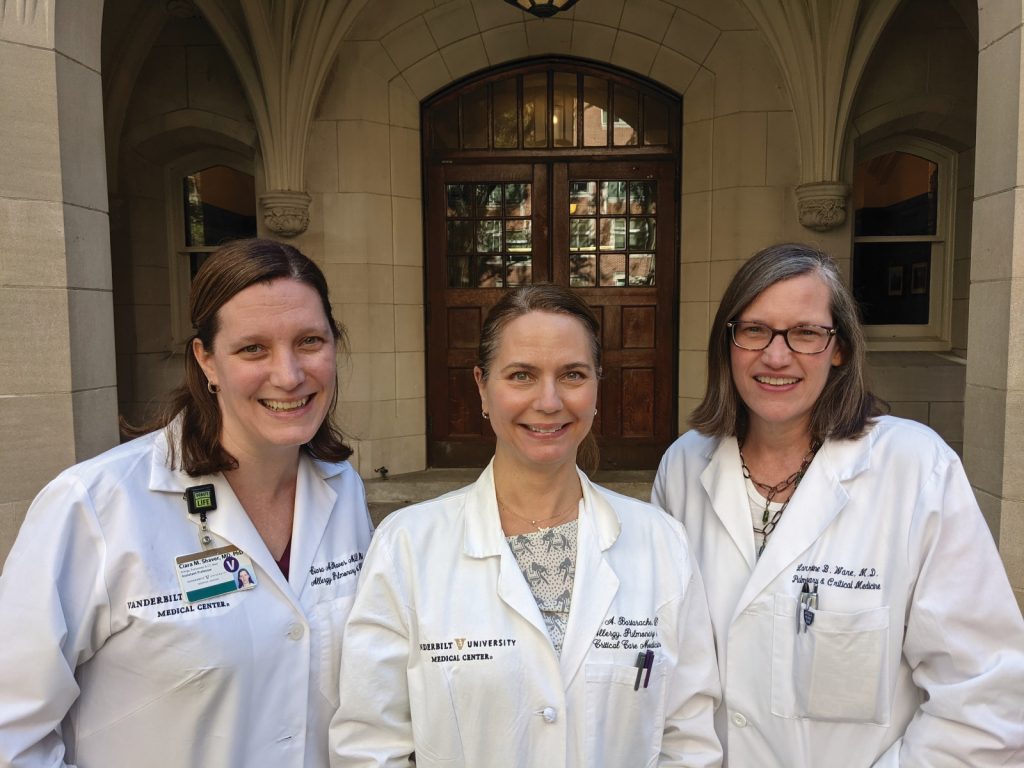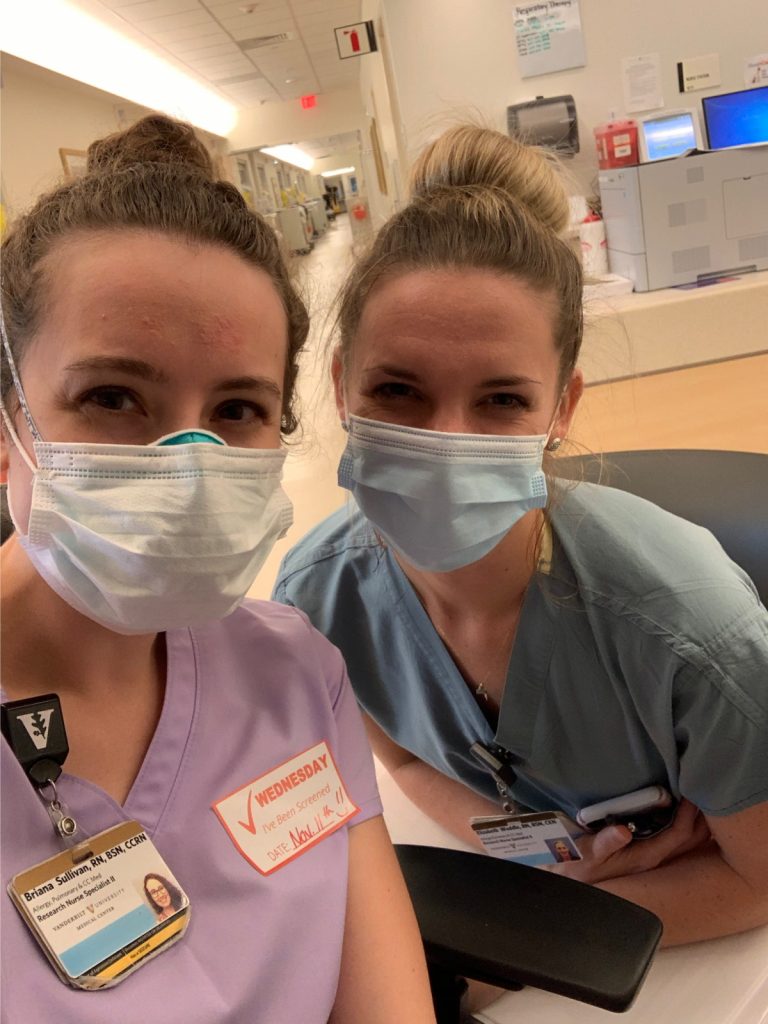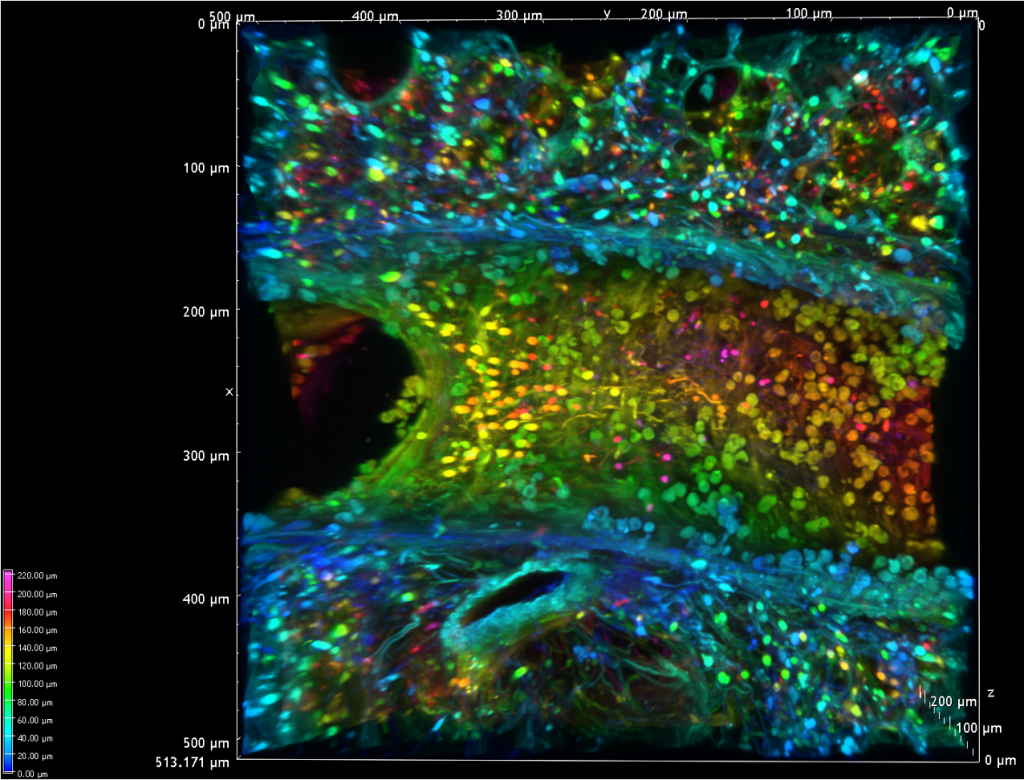Bedside to bench to bedside: a unique way to treat lung injury
Acute respiratory distress syndrome (ARDS) is a severe lung injury that results from multiple different causes including pneumonia, COVID-19 and sepsis. Using human lung models and a ‘bedside to bench to bedside’ approach, physician-scientist Dr Julie Bastarache, of Vanderbilt University Medical Center in the US, is working to understand and treat ARDS in patients suffering from lung damage
TALK LIKE A PHYSICIAN-SCIENTIST
ACUTE RESPIRATORY DISTRESS SYNDROME (ARDS) – a cause of severe respiratory failure as a result of a serious injury or infection
CELL-FREE HAEMOGLOBIN (CFH) – haemoglobin leaked from red blood cells due to a weakening of the cell membrane after illness
HAEMOGLOBIN – an iron-containing protein in red blood cells which is responsible for carrying oxygen and carbon dioxide around the body
SEPSIS – an infection in the body that can lead to ARDS
Acute respiratory distress syndrome (ARDS) develops after a triggering event, such as pneumonia (an infection in the lungs), sepsis (an infection in the body) or severe trauma (like that caused by a car accident). Patients have difficulty breathing due to low oxygen levels in the blood and fluid collecting in the air sacs of their lungs. Many people experiencing ARDS end up in hospital, some needing mechanical ventilation to provide oxygen to the lungs. Despite being a common problem, many people still die from ARDS and currently there is no specific treatment.
Dr Julie Bastarache is physician-scientist at Vanderbilt University Medical Center, working in a hospital as a medical doctor alongside working in a lab, researching the medical issues she encounters while on the ward. Using a ‘bedside to bench’ method, she observes human patients directly and then investigates her observations in the lab. Julie is using this method to better understand ARDS, and she hopes to develop a treatment that will enable doctors to prevent or reverse lung damage.
HOW DOES CELL-FREE HAEMOGLOBIN CAUSE ARDS?
Healthy red blood cells are full of a protein called haemoglobin, which carries oxygen and carbon dioxide around the body. The membrane of these blood cells is very flexible, allowing them to squeeze through very small blood vessels. However, when people are ill, for example with sepsis, this membrane becomes thinner and stiffer, causing the membrane to burst when it tries to fit through blood vessels. This releases haemoglobin into the bloodstream, producing cell-free haemoglobin (CFH) that is no longer contained within red blood cells.
Not only does CFH no longer bind oxygen, it also injures the cells that line the blood vessels (the endothelium) and the cells lining the air sacs in the lung (the epithelium). These layers become leaky, resulting in blood plasma entering the lungs and filling up the air sacs, causing inflammation and making it difficult for the patient to breathe and get oxygen into their blood.
FROM BEDSIDE TO BENCH
Julie describes her research methods as a ‘bedside to bench’ approach. Scientific discoveries begin as observations made at a patient’s bedside, then the causes behind them are studied at a laboratory workbench. The hope is that results can then be translated back to the bedside, to provide treatments for the patients.
“To make sure we are studying molecules and pathways that are important in human disease, many of our studies start with observations that we make in human patients,” Julie says. She collects, with permission, blood and lung samples from patients suffering from ARDS, which are later studied in her research lab to find proteins and other markers that may be part of the disease.
Julie’s discovery of the link between CFH and ARDS was an example of this ‘bedside to bench’ method. “In one of our studies, we found that blood and lung fluid from patients with ARDS had high levels of CFH,” Julie explains. “We then took this observation back to the lab to study how CFH might be helping to cause lung injury.” Using this method, Julie can start to understand the role that CFH plays in causing ARDS and hopefully develop a treatment to prevent it.
THE HUMAN LUNG MODEL
To develop treatments, Julie first needs to understand the biological pathways that cause CFH to damage the lungs. This requires the use of experimental models. “Experimental models allow the scientist to change variables to test the effects of those changes,” explains Julie. No individual model is perfect, so these types of studies normally involve multiple models to focus on different aspects of a biological pathway.
This was the case in the experimental models set up by Julie. One of Julie’s models cultured cells in a dish to study the molecular pathways of CFH effects, another used mouse models to test the effect of CFH in a living system. As well as this, a unique model of human lungs was used to test different therapeutic treatments in patients.
The human lung model is incredibly important in understanding how to treat ARDS. Only specialised research groups have access to human lungs, donated by people who allow their organs to be used for scientific purposes when they die. If the lung is not healthy enough to be transplanted into another person, the lung can be used by researchers like Julie for a more accurate way to test the effect of treatments on the lungs, which models in mice and cells cannot provide.
TREATING PATIENTS WITH ARDS
Once in the lab, Julie provides the lungs with oxygen, then studies what the effects of CFH are on the lung. During her research, Julie found that a very common over-the-counter medicine, acetaminophen/paracetamol, can fight the effects of CFH in patients with sepsis. Thanks to Julie’s access to patients suffering from ARDS, she was able go back to the ‘bedside’ to do an early-stage clinical trial to see if this treatment works. “The results of this small study were positive,” says Julie, “and we are now working on a larger study to test this in more patients.” This link between laboratory research and patients is essential to quickly find a treatment that is effective at preventing ARDS.
Looking to the future, Julie hopes to continue learning more in the lab, focusing on understanding other biological pathways important in ARDS, as well as the genetic and environmental factors that may be important in causing ARDS. “Our hope is that we can take more things we learn in the lab and test them in patients with ARDS,” she says. Julie’s ‘bedside to bench back to bedside’ approach has, “established a natural cycle of scientific discovery”. Physician-scientists are therefore essential in providing a link between hospitals and research labs, not only making it easier to quickly diagnose diseases, but also to develop treatments and cures.
 DR JULIE BASTARACHE
DR JULIE BASTARACHE
Vanderbilt University Medical Center, USA
FIELD OF RESEARCH: Physician-scientist
RESEARCH PROJECT: Studying the effects of cell-free haemoglobin on acute respiratory distress syndrome, in a dual role as a medical doctor and lab researcher
FUNDER: National Institutes of Health (NIH)
ABOUT PHYSICIAN-SCIENTISTS
The unique feature of a physician-scientist is that they perform a dual role, working as a doctor in a hospital while also undertaking research in a laboratory. Physician-scientists are incredibly important in providing a link between patients in hospitals and research labs trying to treat the diseases these patients have. Without physician-scientists like Julie, many diseases would not be thoroughly researched, and research in labs may not lead to therapeutic treatments given to patients. Physician-scientists are, therefore, key figures in medical research.
WHAT DOES JULIE FIND MOST REWARDING AND CHALLENGING ABOUT HER ROLE?
Julie loves her dual role as a physician-scientist, though she found it difficult to switch between roles when she began. With more experience, the transition came more naturally, and each role motivates her for the other. “When I am working in the intensive care unit (ICU), I get excited about new clinical observations and questions that arise in the ICU that I can take back to the lab,” she says. “And similarly, when I’ve been working in the lab for a couple of months, it’s exciting to take a break from that and care for patients.”
WHY IS COLLABORATION IMPORTANT FOR JULIE’S RESEARCH?
Julie is one of three principal investigators leading her lab. This is an uncommon set-up, despite the highly collaborative nature of science. Each principal investigator approaches the problem of treating ARDS in a different way, so Julie’s work involves a lot of collaboration, without which a ‘bedside to bench to bedside’ approach would not work. “It’s also incredibly fun to work so closely with my colleagues on a daily basis,” says Julie. “I wouldn’t want to work any other way!”
Reference
https://doi.org/10.33424/FUTURUM261
BREXIT – the name given to the UK withdrawal from the EU
EUROPEAN UNION (EU) – an economic and political partnership of 27 European countries that share laws in many areas. These include the ability of citizens to freely travel and work in different member countries and the ability of member countries to freely trade with each other
LEAVE – the campaign for the UK to leave the EU
REFERENDUM – a public vote on a single political question. In the Brexit referendum, voters were asked ‘Should the United Kingdom remain a member of the European Union or leave the European Union?’
REMAIN – the campaign for the UK to remain in the EU
THINK TANK – a group outside the government which makes policy proposals
UNITED KINGDOM (UK) – the union of England, Scotland, Wales and Northern Ireland
In recent years, the world seems to have become increasingly divided. Brexit is a prime example of this, as the UK was split 52:48 on whether the UK should leave the European Union (EU) or remain a member.
The Brexit referendum took place on 23rd June 2016, but before people went to the polling booths, there were hard-fought campaigns on both sides from politicians, influential people and organisations who tried to persuade voters of the merits of ‘Leave’ or ‘Remain’. Contradictory claims about the consequences of the two possible outcomes were made, which were often difficult to verify but impossible to ignore. Remain campaigners claimed 820,000 jobs would be lost if the UK left the EU, while Leave campaigners claimed leaving would allow £350 million a week to be spent on the NHS. A heavily contested campaign ended with a very close result: the UK voted to leave the EU by 51.9% to 48.1%.
After several years of negotiations, the UK formally left the EU. Exit was completed on 31st December 2020 when the 11-month transition period ended. So, what have the impacts of Brexit been? Sarah Overton and Joël Reland, from the UK in a Changing Europe think tank based at King’s College London, are looking into this.
EVALUATING THE IMPACTS OF BREXIT
UK in a Changing Europe provides impartial research and analysis about Brexit and its effects on the UK and EU. Sarah, Joël and the rest of the team are working to understand more about the consequences of Brexit. “There’s no exact science for evaluating the impacts of Brexit,” says Sarah, “but we commonly use methods of data analysis.” For example, Sarah and Joël have compared official statistics from the UK and EU about the labour market and other aspects of the UK economy to investigate issues such as wage growth and inflation since Brexit. They also regularly analyse polling data to understand how the public views the impacts of Brexit.
As such a vast topic, studying the impacts of Brexit is challenging. “There is an almost endless range of policy areas which could be affected by Brexit,” says Joël. So, the team must go through policy documents, websites and press releases, identifying which policy changes and developments are significant. But, even this does not give a complete picture. Another challenge is that Leave voters wanted benefits such as ‘control’ and sovereignty, which are not measurable in a physical sense and so are hard to quantify.
It transpires that a number of the pre-Brexit claims made by the Leave and Remain campaigns were unfounded. The prediction of 820,000 jobs being lost due to Brexit has not been borne out. And the NHS is not receiving £350 million more a week now that the UK is no longer in the EU (this particular claim was found to be a ‘clear misuse of official statistics’). These examples highlight how both campaigns used (or in some cases, misused) statistics to persuade voters.
IMPACTS ON THE UNION
The UK is a union of four nations and Brexit is having consequences on this union. The referendum was decided on the basis of the total vote across the whole UK, but there were significant differences in the way different parts of the UK voted. In Scotland, 62% of those who voted in the referendum voted to remain. And polling since the referendum suggests that, on the whole, Scots think the consequences of Brexit have been negative. “The Scottish National Party is now advocating another Scottish independence referendum,” explains Sarah, “arguing that Brexit has changed the terms of Scotland’s place in the UK.”
In Northern Ireland, the majority of voters also voted to remain. “How to keep the Irish border open was probably the most difficult question of UK-EU negotiations,” says Joël. “It was agreed early on that the border had to be kept open to preserve political stability between Northern Ireland and the Republic of Ireland.” This has been achieved by keeping Northern Ireland aligned with many EU laws, in an attempt to keep a free flow of trade across the Irish border. But this has practical and political consequences. Checks are now required on many goods crossing from Great Britain into Northern Ireland, resulting in some disruption to trade. “Politically, this is very difficult for the Unionist community in Northern Ireland, whose political identity is inextricably bound up in the idea that they are part of the UK, not Ireland,” says Joël. “The fact that Northern Ireland now follows some different laws to the rest of the UK is challenging to this sense of connection.” In contrast, this fractured connection with the rest of the UK is politically advantageous for the Nationalist community, as the issues caused by Brexit seem to be increasing support for the reunification of Northern Ireland with the Republic of Ireland.
IMPACTS ON EU CITIZENS LIVING IN THE UK
“Ending free movement between the UK and the EU was a priority for many Brexit supporters,” says Sarah. Yet many EU citizens live, work and study in the UK, while many UK citizens live, work and study in the EU. “The UK government had promised that EU nationals would be automatically granted indefinite leave to remain and lose none of their existing rights. However, these commitments were not delivered.”
With no official database of foreign nationals living in the UK, the authorities had no way of telling who had the right to stay in the UK, and who did not. To solve this, the EU Settlement Scheme was launched, enabling EU citizens living in the UK to apply for ‘settled status’. But this must be done online, meaning elderly people and those from vulnerable groups (such as those who are homeless or experiencing mental health issues) are underrepresented in applications.
IMPACTS ON OTHER SECTORS
Before Brexit, EU citizens made up the majority of temporary workers on British farms during the harvest season. Brexit has made it harder for EU seasonal agricultural workers to come to the UK, meaning that in recent years, some crops have been left to rot in their fields as there are not enough workers to harvest them. Under EU law, British farmers could receive financial support from various schemes. Without these payments, some livestock farmers may lose 60-80% of their income. Yet these EU subsidies favoured large landowners and had negative impacts on smaller farms, and so Brexit has provided opportunities for farming reform in the UK.
 DR JULIE BASTARACHE
DR JULIE BASTARACHE
Vanderbilt University Medical Center, USA
FIELD OF RESEARCH: Physician-scientist
RESEARCH PROJECT: Studying the effects of cell-free haemoglobin on acute respiratory distress syndrome, in a dual role as a medical doctor and lab researcher
FUNDER: National Institutes of Health (NIH)
ABOUT POLITICS AND FOREIGN AFFAIRS
Politics and foreign affairs encompasses a wide range of different topics relating to domestic and foreign political activities. Political scientists may work as researchers, like Sarah and Joël, investigating how national and international governments and policies influence political landscapes. Or they may work as political forecasters, trying to determine what the outcomes of political decisions or elections will be, based on past political events.
As the topic of Brexit has highlighted, politics can be very divisive. So, it is very important that researchers such as Sarah and Joël remain impartial and conduct their research objectively and without prejudice.
WHAT DO POLITICAL SCIENTISTS DO?
There is no such thing as a typical day for a political scientist! The nature of the field means that researchers are constantly updating their topics of investigation as current affairs develop. Daily tasks include researching current political activities, writing articles about political issues, and planning and coordinating long-term projects. Sarah and Joël regularly interview politicians and government officials for the UK in a Changing Europe Brexit Witness Archive (www.ukandeu.ac.uk/brexit-witness-archive), to provide a record of the experiences of those who have shaped the Brexit process. They also monitor the impacts of Brexit in close to real time through the UK in a Changing Europe regulatory divergence tracker (www.ukandeu.ac.uk/research-papers/uk-eu-regulatory-divergence-tracker).
Political scientists study topics ranging from how parliaments and governments work, to political parties’ campaigns, to public attitudes on political topics, and more. “Political scientists evaluate problems,” says Sarah. “Research may involve conducting interviews and focus groups or analysing qualitative and quantitative data.”
WHAT WILL THE NEXT GENERATION OF BREXIT RESEARCHERS INVESTIGATE?
“There’s still a lot of work to do monitoring, analysing and evaluating the impacts of Brexit on the UK and on its relations with other countries,” explains Joël. “The UK-EU relationship will continue to develop, so we expect future researchers will be thinking about the implications of that relationship and how it might continue to change going forward.”
WHAT DOES THE FUTURE LOOK LIKE FOR PHYSICIAN-SCIENTISTS?
“Physician-scientists require work environments that value their special contribution to both medicine and science,” explains Julie. Unfortunately, governments, hospitals and academic medical centres face financial pressures which make it difficult for them to support the unique position of physician-scientists. “It is important that the current and future generations advocate for support of physician-scientists at all levels, from international to national to local.”
EXPLORE A CAREER AS A PHYSICIAN-SCIENTIST
• There are several different paths to becoming a physician-scientist. These websites contain a lot of information, including funding opportunities available to support physician-scientists:
o www.aamc.org/what-we-do/mission-areas/medical-research/physician-scientist
o www.physicianscientists.org
• Julie’s lab, The Laboratory for Science and Translation in Critical Illness (www.lstci.org), hosts summer students through programmes run by her institution for high school and undergraduate students.
• Talk to a physician-scientist to see what their job is like. Most work at large academic medical centres such as university hospitals. Don’t be afraid to email and ask to meet them! You can contact Julie and her team through their website: www.lstci.org
PATHWAY FROM SCHOOL TO PHYSICIAN-SCIENTIST
Alongside the traditional pre-medical courses needed to get into medical school in the US, Julie encourages students to take the subjects that interest them. “Everything you need to know to become a physician-scientist is taught during medical school and post-doctoral fellowship training,” says Julie, “so pursue whatever interests you as a high school or undergraduate student.” Julie majored in biology, but took other classes in English, art and music during her undergraduate degree.
To learn what subjects you should take at school to study medicine, visit the following links:
• US and Canada: www.medapplications.com/pre-medical-programs
• UK: www.ucas.com/explore/subjects/medicine-and-allied-subjects
• Europe: www.mastersportal.com/articles/1801/what-are-the-entry-requirements-for-medical-schools-in-europe-and-the-us.html
HOW DID JULIE BECOME A PHYSICIAN-SCIENTIST?
WHAT WERE YOUR INTERESTS WHEN YOU WERE YOUNGER?
I always loved science as a kid. I had a chemistry set in the 1980s, when chemistry sets were allowed to contain actual chemicals. I loved going to the science museum and learning about science in any way I could. My favourite show was Mr Wizard’s World, a show where Mr Wizard would do science experiments and demonstrations with kids. Although I loved science, I did entertain other careers such as becoming a magician or detective. Interestingly, being a scientist is kind of both.
WHO OR WHAT INSPIRED YOU TO BECOME A PHYSICIAN-SCIENTIST?
I grew up in a very small town and didn’t know any physicians, let alone physician-scientists. I didn’t even know that physician-scientists existed until I was finished with medical school and was a physician myself. As part of my fellowship training in pulmonary and critical care medicine, I had to do two years of research. I chose to work with Dr Lorraine Ware on a basic science project studying a blood coagulation protein called tissue factor. I completely fell in love with research and decided that I wanted to pursue a career as a physician-scientist.
HOW IMPORTANT HAS MENTORING BEEN IN YOUR CAREER?
Mentorship is probably the most important factor in a physician-scientist’s success and happiness, even more important than the actual project. I was fortunate to have an amazing mentor in Dr Lorraine Ware. We had such a great working relationship that as I grew as a scientist, we decided to continue working together as colleagues. Then, my first mentee, Dr Ciara Shaver, made the same decision and stayed on as part of our group. Now, we are three physician-scientists who lead our large lab group.
HOW DO YOU SWITCH OFF FROM YOUR WORK?
I have young children so as soon as I go home, I become ‘mom’ and enjoy my time with family. When I had children, I made a conscious decision to spend as much time as possible with them when I was home. When I get home, it’s family time and I don’t do any more work until the kids go to bed. I also enjoy reading lots of non-fiction and jogging when I have time.
WHAT ARE YOUR PROUDEST CAREER ACHIEVEMENTS SO FAR?
Being a mentor is so rewarding. It is amazing to see my mentees succeed. I am also proud of the incredible group of students, technicians, research nurses and trainees in our lab. We have an amazing group and work hard to foster an inclusive, supportive environment in which people can thrive.
JULIE’S TOP TIPS
01 Work and study hard.
02 Keep an open mind.
03 Be curious and ask questions.
04 Take advantage of opportunities.
05 Step out of your comfort zone.
Do you have a question for Julie?
Write it in the comments box below and Julie will get back to you. (Remember, researchers are very busy people, so you may have to wait a few days.)

